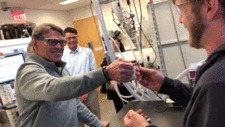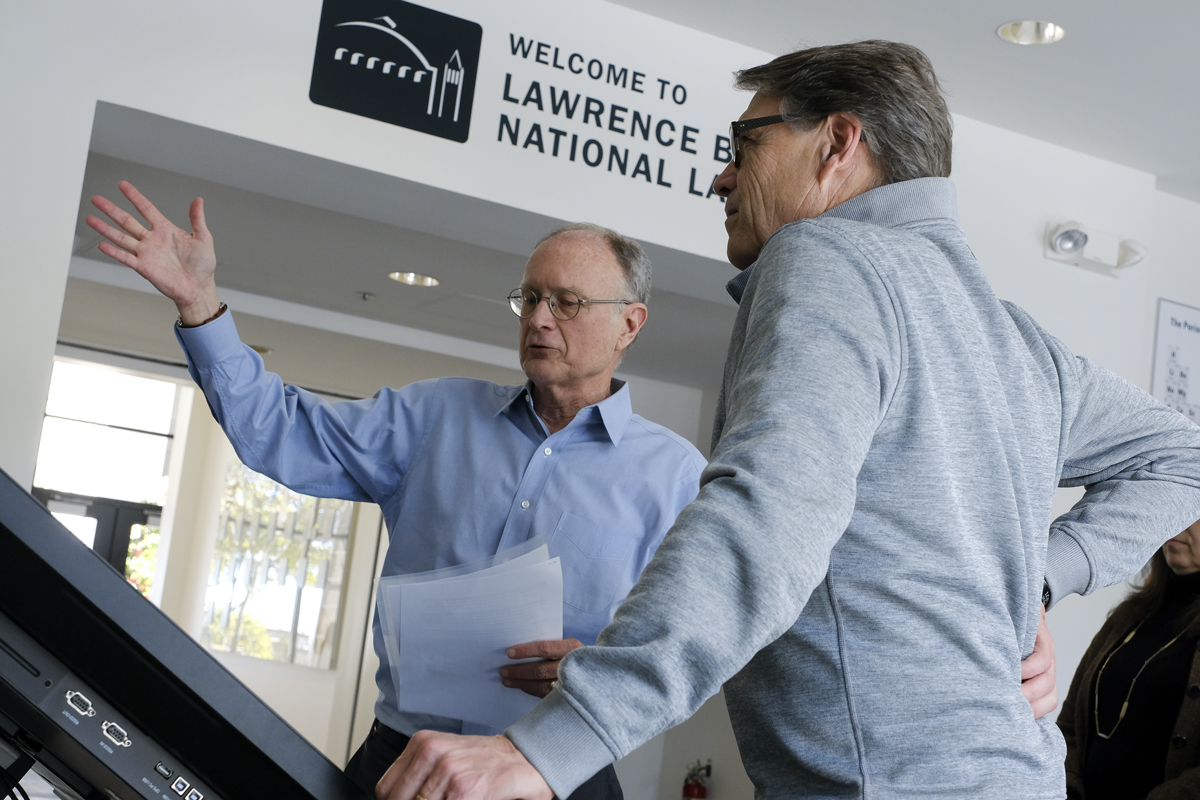VIDEO: Secretary of Energy Rick Perry visited Berkeley Lab on March 27, stopping at the Advanced Light Source, Molecular Foundry, NERSC, and ESnet. During his visit, he spoke to many scientists about their research. This video captures what he saw and uses his own words to describe what he learned. (Credit: Marilyn Chung/Berkeley Lab)
Secretary of Energy Rick Perry visited the Department of Energy’s Lawrence Berkeley National Laboratory (Berkeley Lab) today, getting a firsthand view of how Berkeley Lab combines team science with world-class facilities to develop solutions for the scientific, energy, and technological challenges facing the nation.
As the top official at the Department of Energy, Perry oversees Berkeley Lab and the 16 other DOE national laboratories that form the backbone of the nation’s scientific infrastructure.
His visit began with a welcome and brief introduction to Berkeley Lab, followed by tours of several of the Lab’s DOE Office of Science user facilities, which provide state-of-the-art resources for scientists across the nation and around the world. After the tour, Perry addressed the Berkeley Lab community in a town hall meeting that was livestreamed to Lab staff.
“One of the things that I enjoy as much about this job as anything, is going and telling the uninitiated about what’s happening at the national labs in this country. Your engagement in the future of the sciences, in innovation and knowledge, is invaluable,” said Secretary Perry at the town hall.
“We greatly appreciate Secretary Perry for spending time with us today and learning about our lab, our science, and our researchers,” said Berkeley Lab Director Mike Witherell, who hosted the visit and introduced Perry at the town hall. “The Secretary is a strong and effective advocate for the idea that the research capabilities at the national laboratories represent the primary national asset to address the nation’s energy and environmental challenges.”
At the Advanced Light Source, which specializes in producing extremely bright X-ray light for examining the atomic and electronic structure of materials, Perry learned how Lab scientists are working with chipmakers to develop next-gen extreme ultraviolet (EUV) photolithography, an advanced semiconductor manufacturing technology. He visited beamlines optimized for battery research, and microtomography to study materials in extreme detail.

In this looping video, Energy Secretary Rick Perry, left, and Berkeley Lab’s Raymond Weitekamp struggle to break a 3-D-printed wishbone made of a rugged COR Alpha polymer material at Berkeley Lab’s Molecular Foundry. (Credit: Kelly J. Owen/Berkeley Lab)
The next stop was the Molecular Foundry, which provides users with expert staff and instrumentation for multidisciplinary nanoscale research. Perry met with an industry scientist who is using the facility to develop biomaging probes for cancer detection. He took the controls of the TEAM 0.5 electron microscope, one of the world’s most powerful microscopes.
Perry also received an overview of Cyclotron Road, a program that identifies promising early-career innovators and provides them with the resources needed to commercialize their technologies.
And then it was on to Shyh Wang Hall for a tour of the National Energy Research Scientific Computing Center (NERSC), one of the world’s leading supercomputing centers for open science, and the primary scientific computing facility for the Office of Science. As part of the tour, Perry signed a panel on Cori, which is NERSC’s newest supercomputer.
He learned about the Energy Sciences Network (ESnet), the world’s fastest network dedicated to science, connecting tens of thousands of scientists as they collaborate on solving some of the world’s biggest scientific challenges.
###
Lawrence Berkeley National Laboratory addresses the world’s most urgent scientific challenges by advancing sustainable energy, protecting human health, creating new materials, and revealing the origin and fate of the universe. Founded in 1931, Berkeley Lab’s scientific expertise has been recognized with 13 Nobel Prizes. The University of California manages Berkeley Lab for the U.S. Department of Energy’s Office of Science. For more, visit www.lbl.gov.
DOE’s Office of Science is the single largest supporter of basic research in the physical sciences in the United States, and is working to address some of the most pressing challenges of our time. For more information, please visit science.energy.gov.
